Autistic People Don’t “Get Used to” Sensory Triggers We Are Forced to Endure, We Disassociate From Them
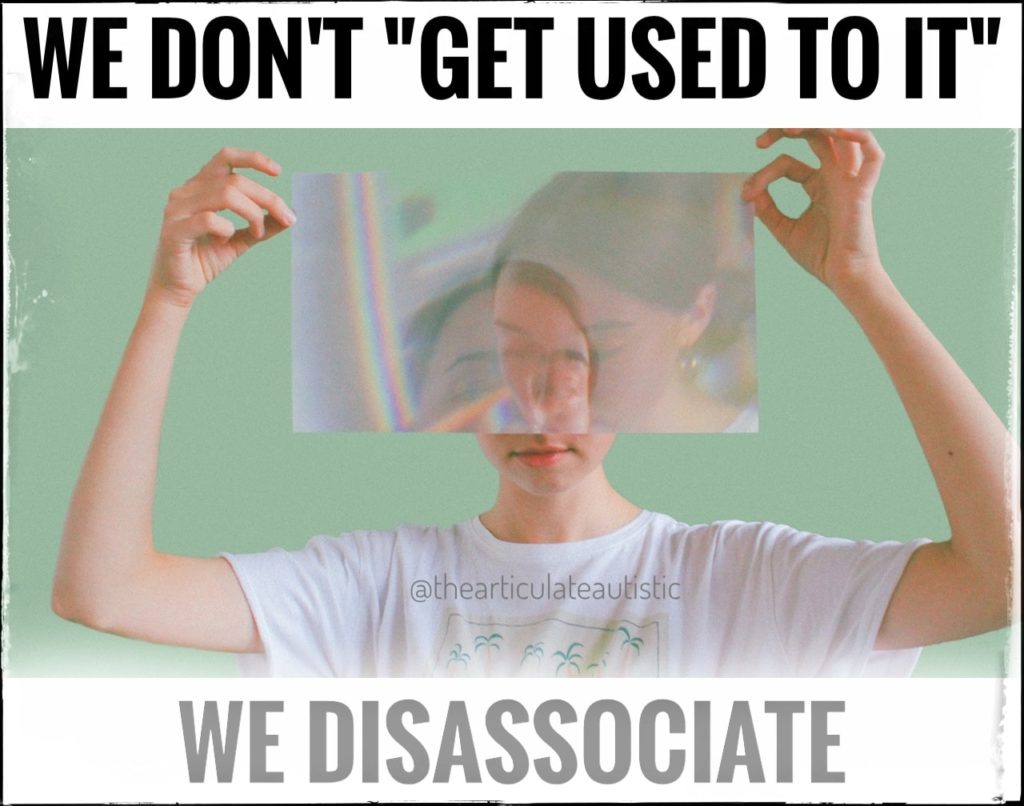
This is going to be a hard truth for some, so brace yourselves:
Most autistic people do not “get used to” sensory triggers just because we are forcibly and repeatedly exposed to them; we disassociate from everything in a last and desperate attempt to stop the torturous input.
Read that again.
Now, slow and guided exposure that the autistic person has agreed upon is different. With people who are 100% sympathetic to and understanding of the validity of these sensory challenges, it is possible to work through or around them.
(Article continues below.)
The best way to improve communication with your autistic loved one is to understand how your autistic loved one’s mind works! Intentions, motivations, and personal expressions (facial expressions or lack thereof, body language, etc.), are often quite different in autistic people than they are in neurotypical people.
Experience a better understanding of your autistic loved one by reading books about life from an autistic perspective as well as stories that feature autistic characters. You’ll have so many “Ah ha!” moments and start seeing your autistic loved one in a different light (and you’ll have a better understanding of their behaviors, which you may have been misinterpreting up until now).
Books I recommend for a better understanding of your autistic loved one:
But, just exposing an autistic person to a painful sound, texture, smell, light, etc., because “the real world isn’t sensory friendly” is not doing anything to toughen the person up and prepare them to fit into a non-autistic society.
It teaches us to become numb. I disassociated most of my childhood, teenage years, and my twenties, and I wasn’t even aware of it.
Yes, autistic people can be deep in our own minds a lot due to passionate interests and sensory overwhelm, but being forced to endure what is horrific sensory input for us day after day, month after month, year after year, will cause us to just shut down completely, and then nothing is getting in anymore.
Not love, not joy, not friendship, not connection. Nothing.
This type of disassociation is NOT an inherent autistic trait, it is a trauma response.
There is a huge, night and day difference between disassociation, shoving down and stifling emotional responses, and masking and ACTUALLY getting used to something and no longer being as deeply affected by it.
In other words, just because someone can train themselves to walk over hot coals without screaming doesn’t mean they don’t still feel the pain.
Follow me on Instagram.
Want downloadable, PDF-format copies of these blog posts to print and use with your loved ones or small class? Click here to become a Patreon supporter!
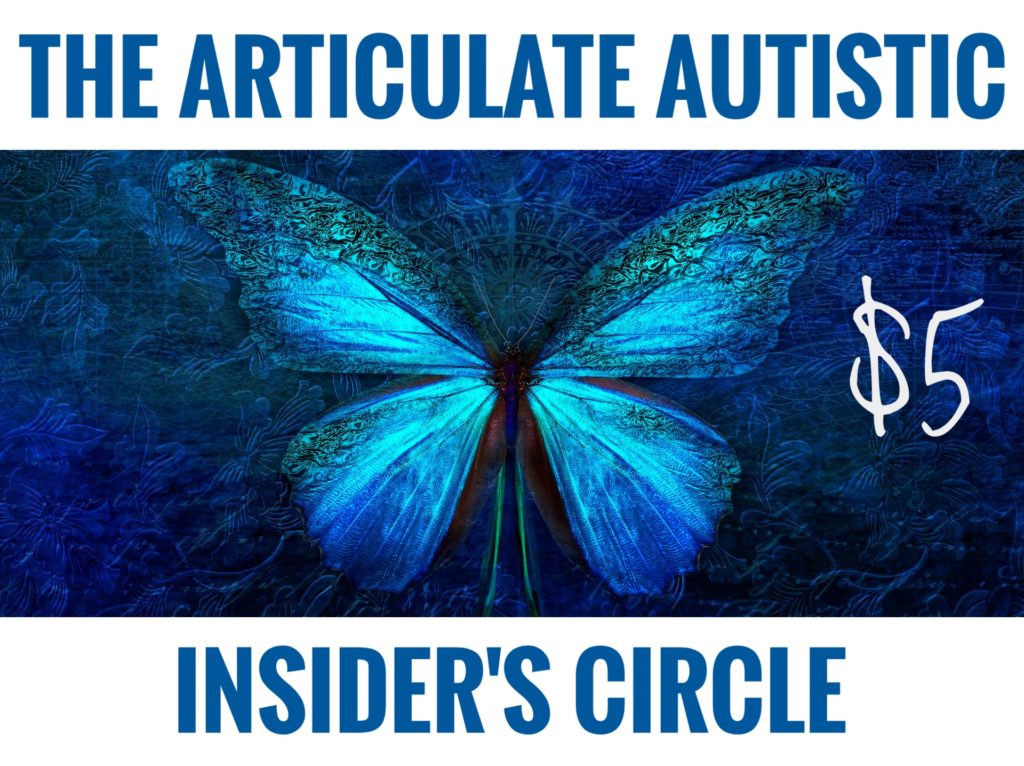
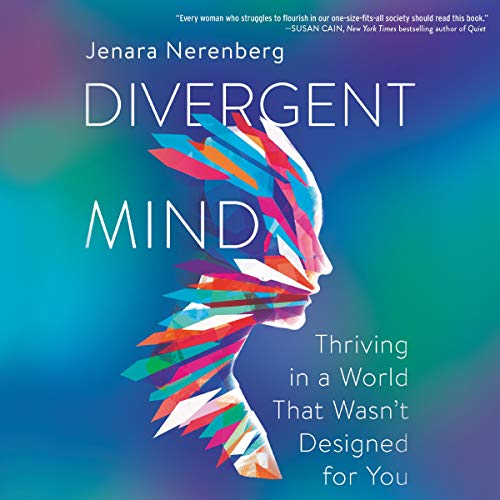
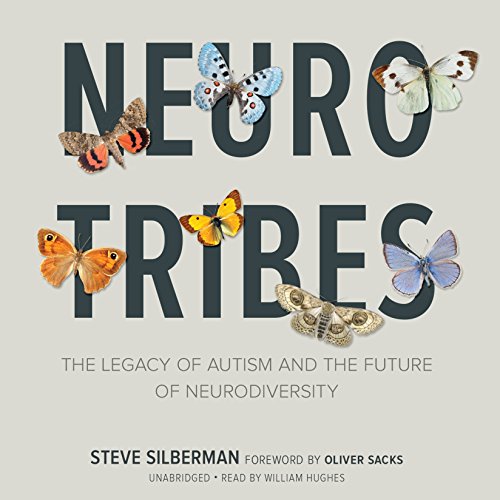
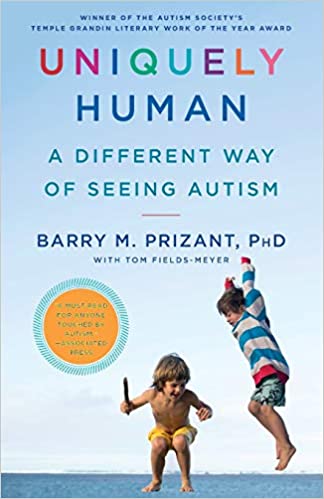

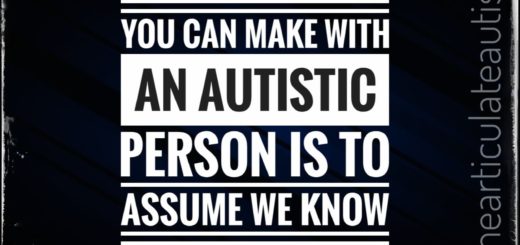

Thank you for this. I am still learning
How can you tell if you’re dissociating? I am pretty oblivious to sensory stuff (and interoception) most of the time. I HATED pregnancy, though, because I felt like I was pulled out of my brain into physical awareness by all the new and awful sensory input, and I DIDN’T LIKE IT. Any time my body has anything wrong I can’t ignore I panic a li’l bit. Am I living in constant dissociation? How can I tell?
Hi, Grace. You might be living in constant dissociation. Or, at least a form of it. I know I have to, especially when I’m out and about in public. It’s kind of like I’m there, but not fully. I have to “tone everything down” so to speak, so I can function. I take a lot of sensory breaks (staring, numbing out), which, according to neurotypical people, is “unhealthy”, but, as a neurodivergent person, I have to do it to survive, and a lot of it happens automatically. I still feel connected to the world, but just a bit removed, if that makes any sense. I don’t like being pulled back into my body with sensory input or physical needs. It sucks, but I’ve learned to live with it. I do understand what you’re talking about from that perspective.
I know this may be slightly off topic, but after reading this article, I immediately thought of the Radiohead song How to Disappear Completely (https://www.youtube.com/watch?v=6W6HhdqA95w). I think I’m starting to better understand why it is that this song resonates so strongly with me.
Hi. Your article was very helpful. I am autistic but do not have as many sensory triggers as my young son (he is 8). Do you have any recommendations for how I can help him work with them so he isn’t traumatized by being at school? Thank you!
I’d be happy to help. I’ll send you an email.
I have terrible sensory sensitivities mixed with trauma. I’ve been trying exposure therapy to live in an apartment but I’ve been driven to the point of not wanting to exist. I go into heavy dissasociation to get away from the pain. I have no choice or I’ll be homeless , I’m not sure where to go from here my family knows nothing about neurodivergence nor do they want to learn. Any advice would help. Thanks
I would be happy to help offer whatever tips I can. Please email me at thearticulateautistic@gmail.com.
Hi, your article was a good read. My son (autistic/ADHD) has huge sensory issues, clothes, smells, lights and noise. It gives him migraines and he vomits. He hasn’t been in school since July 2021. Any help would be fabulous as we are still waiting for OT
Hello, Emma. I sent you an email.
Hello could u privately pm(message) me about some autism relatedquestions and concerns I have for myself but I’m not going to publicly share it at this time that I’m becoming sorta aware about and don’t want to live in denial thanks
I sent you an email. 🙂
Hi, thank you for this. What does “slow, guided exposure” look like? My son is afraid of dogs and wishes not to be but I’m not sure how to help him in the right way. I don’t want to encourage him in the wrong way and make him mask or anything? Any advice would be appreciated
Hello. Thank you for your question. I think slow, guided exposure will look a bit different for everyone. In your son’s case, if he’s afraid of dogs, and he genuinely wishes to get over his fear, I would start by introducing him to children’s books about dogs. These are safe and will give him some information he may not already have. Oftentimes, information laid out in clear and concise detail can help our logical brains understand and process what’s going on and how much danger we may be or not be in. If he’s OK with the books, you may be able to move on to videos about dogs. Puppies at first, then adult dogs, then dogs barking (he may be very sensitive to the sound, which may contribute to his fear). If he shows fear, stop the exposure for that day and go back to videos of adult dogs but not barking the next day. Listen to your son and go at his pace. Also, dogs can be unpredictable in their movements and reactions, so a book on dog behavior may help, as well. Knowing what to expect is likely very important to your son. What you do will depend on his age, experience, and comfort level. I hope this helps. Please feel free to ask more questions if need be.
Grr! I get mad at this line of reasoning. “You have to learn to manage without because the real world won’t have special accomodations.” I’m sorry, but have you SEEN the real world? Fuzzy steering wheel covers exist. Tinted glasses. Hand accessories and necklaces. The so-called “real world” totally is full of accomodations. And whatever accomodations it lacks, well, they can and should be added. The curb-cut effect is an example of this. When curbs were designed to have slanted parts like a small ramp, it was originally for blind people, I think. But then, mothers with strollers found it handy too. Any kind of wheeled pedestrian, or someone with unstable footing for any reason, benefits from curb cuts.
Tl;dr: The real world is full of accomodations that autistic people can use. And if there is an accomodation that the real world lacks, then the world should be redisgned to include it, because accomodations are very helpful to all sorts of people, not just autistic or disabled ones. Teaching an autistic person to do without is exactly the wrong approach no matter what.
I have a hard time standing up for myself about my need for sensory friendly space because of the “Get used to it!” attitudes of most neurotypical people especially people who can evict me if I ask for a sensory friendly space.
I have terrible sensory sensitivities mixed with trauma. I’ve been trying exposure therapy to live in an apartment but I’ve been driven to the point of not wanting to exist. I go into heavy dissasociation to get away from the pain. I have no choice or I’ll be homeless , I’m not sure where to go from here my family knows nothing about neurodivergence nor do they want to learn. Any advice would help. Thanks